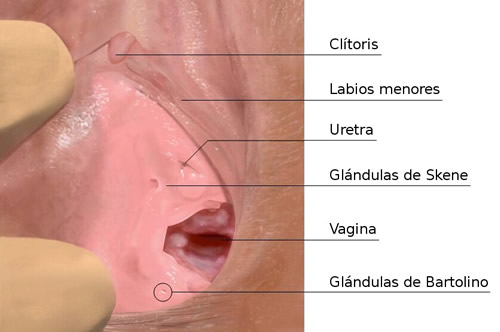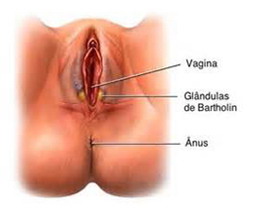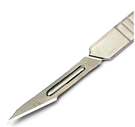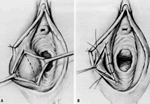Bartholino glands are two glands located in the vaginal introitus, at the entrance of the vulva in the lower third of the inner side of the labia before reaching the hymen, its function is the lubricate the vaginal introitus during intercourse by the hypersecretion on small amounts of mucous liquid lubricant. Its size is less than 5 to 10 mm and they are hardly palpable when they are healthy.
The amount of lubricant secreted is minimal and only serves to the preamble, the thickness of lubrication which allows intercourse and maintain vaginal health comes from the cervix and vaginal walls. Their removal has no impact on genital lubrication.
The clinical significance of the glands is related to local obstruction and infection. Glandular duct obstruction leads to cysts which in turn can become infected and produce abscesses of the gland. The problem is usually unilateral
Approximately 2% of the annual consultations are related to the formation of cyst or abscess of Bartholin's gland.
Why Barholino lines become clogged
Trauma local (sex, sex toys, masturbation, spinning – bike – use), infections (Candida vulvovaginitis, STDs such as gonorrhea and chlamydia), use of dental wires (panties) and any form of local inflammation clog the glands
Bartholino gland cysts
Simple obstruction of the gland leads to the Bartholino gland cysts. These grow as time passes and may have the size of a medium lemon (4-5 cm in diameter). Cysts usually are painless but generate feeling of weight and obstruction during intercourse. Its content is mucous, thick and transparent to reddish color.
Bartholino gland abscess
The Bartolinitis, Bartholin's gland infection, occurs when infected mucous cyst contents. The causative organism most frequently involved in the infection of the glands are coliform bacteria that are found in the rectum. The most frequently cultivated bacteria is Escherichia coli (the most frequent cause of urinary tract infections in women) and occasionally some considered agents of STDs such as chlamydia and gonorrhea
Gland abscess is extremely painful, indeed prevents sexual intercourse, going to the bathroom and walk normally, there may be local cellulitis and rarely there is fever as a result of the infection. In general it is an infection very well located in patients immune competent, patient immuno suppressed may be fever and even potentially life-threatening conditions such as sepsis
Diagnosis
Diagnosis is extremely simple because a tumoral lesion on vulva is evident at a glance. In my cases the left side has been the most affected outraged. I've never seen a bilateral case.
Cysts do not hurt or just generate feeling of pressure. Furthermore, abscesses are usually very painful, however there are patients carrying little or no symptomatic chronic abscesses.
Treatment
If there is infection treatment is based on the drainage of the lesion and the use of oral antibiotics.
Drainage by puncture and aspiration: If there isn't a lot of pain and gland appears to be infected can be drained by puncture/aspiration by plastic inject. The problem of this option is that there is a very high recurrence rate but can rapidly improve pain in case of infection.
Drainage by incision: If the volume is relatively large and the area is very painful I use a scalpel to make a quick incision in the gland to drain immediately. Do not use anesthesia anesthetic infiltration Burns much and that creates even more pain in the area. And you don't have, the patient does not feel the puncture, only the relief of local decompression.
Drainage produces a thick purulent fluid or pus-like heme (containing pus and blood) and usually has no smell since the bacteria involved are not producing gas.
The rate of recurrence after drainage under these conditions can reach 30%, but as an immediate measure to alleviate the pain and local discomfort it is highly effective.
Drainage by catheter in Wood: Wood catheter is a small catheter with a balloon at its distal end and is inserted within the gland the balloon and it will drain the gland for two to four weeks to be removed the ball this will generate a small orif Service fistula which will allow the subsequent drainage of gland with less chance for recurrence.
If you require the ultimate cure there are certain surgical techniques that require the use of a minor surgery operating room or an operating room of traditional surgery.
Marsupialization: drainage of gland Bartholino through a large incision that will be closed her lips so that is a hole that exposed the interior of the gland to the outside, this ensures the drainage of the gland in the future. Although it is effective it may be unacceptable from the aesthetic point of view for many women
Total resection of the gland: the definitive cure is the removal of the affected gland. Reserves this method for recurrent cases that don't respond to treatment less invasive.
The patient must go to the operating room and anesthesia, usually anesthesia epidural, practiced total resection of the affected gland preventing bleeding and injuries of sensory nerves in the area. We try to avoid rupture of the cyst to use their limits to dissect it and ensure total resection of the gland.
Anatomy and localization
In this real photo only holes in ducts can be seen, the glands are not nor can be felt due to the fact that they are normal.

On this scheme you can see in their anatomical location:

And with a cyst or abscess:
Treatment
Puncture drainage: it punctured and drained the gland, anesthesia is not used.

Drainage by incision: I use a blade of knife #11 (Lancet) and pierced the gland without using local anesthesia since infiltrating the area with local anesthetic is extremely painful. Drilling is practically painless and drainage occurs quickly obtaining immediate symptomatic improvement.

Marsupialization: gland is surgically opened and drained the contents are stitched edges to keep it open to the outside and ensuring its drainage. The recurrence rate is low for this procedure. Practiced in the operating room.

Glandular Exceresis: the total number of the affected gland is surgically removed.

